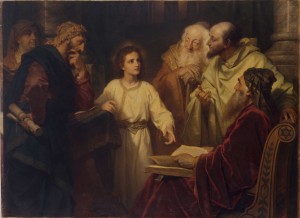
A new art exhibition, “Sacred Gifts: The Religious Art of Carl Bloch, Heinrich Hofmann and Frans Schwartz,” is set to open on Nov. 15 at BYU’s Museum of Art.
Taking a walk through the main floor of the MOA, patrons will notice that preparations for this exhibition are taking a large portion of the museum’s time and efforts. Carpenters, painters and a slew of technicians are working daily to bring this one-of-a-kind exhibition to life.
The museum is trying to recreate the atmosphere that accompanies the artwork in its traditional setting, namely in Swedish and Danish churches. Because many of the paintings are altar pieces, the atmosphere of their traditional settings is preserved for the exhibition.
The three 19th-century artists represent some of the most famous names in Christ-centered artwork. Many of the pieces have been featured across Europe in various houses of worship and castles. Bloch’s “Christ at Emmaus,” for example, is originally housed at Löderups Kyrka, a church located in Sweden.
The exhibition is expected to draw record crowds to the museum, according to Dawn Pheysey, the head curator of the museum.
“The Carl Bloch exhibition (brought) over 306,000 people, which is a sizable number to attend an exhibition,” Pheysey said. “This time we do expect more. We’ve done priority registration already, and the first two days are full.”
Patrons can go to the exhibition’s website at sacredgifts.byu.edu to reserve tickets to view the artwork. This ensures that overcrowding does not occur during peak times, allowing everyone to have the best possible art-viewing experience.
“This time what we’re trying to do is encourage people to come at the beginning and during the day when it’s not quite as crowded so they can have a better experience,” Pheysey said.
Students and employees of BYU are looking forward to the exhibition, especially after the impact the past Bloch exhibition brought.
“I loved the first Carl Bloch exhibition, so I plan on going to the next one,” said Wilda Watts, office manager at BYU Independent Study. “So many of the paintings are familiar to us since they are the pictures that we use in church. To see the real paintings and to see them up close, you are able to catch the emotion and see so much more of what’s going on in the painting. Seeing the real work was just amazing.”
The museum hopes to educate youth and bring Christ-centered culture to them through the exhibition. Krisanne Hastings, Family and K-12 coordinator for the BYU Museum of Art, hopes the exhibition will be a source of light for the younger generation.
“Children are so naturally creative and inherently inclined toward the visual arts. I think the grandiosity of these works — the scale, the color, the shapes, the narratives — will draw them in, but I think the central content matter — our Savior Jesus Christ — will speak to them on a level beyond aesthetic appeal,” Hastings said.
The exhibition will run until May 10 at BYU’s Museum of Art.




